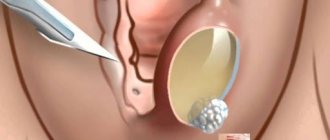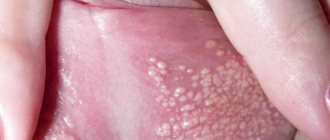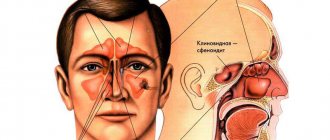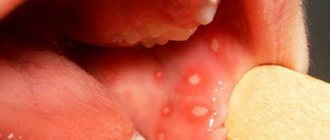Causes of cheilitis
Exposure to adverse weather conditions.
The disease often develops as a result of exposure to unfavorable climatic factors, which include ultraviolet radiation, too low or high air temperature. For this reason, cheilitis often affects people whose work involves regular exposure to fresh air.
Development of an allergic reaction.
One of the reasons for the development of cheilitis is an increase in the sensitivity of the lips to various irritants, mainly of chemical origin.
In this case, the area of the red border of the lips is most often affected and, less often, the mucous membrane. If you do not consult a doctor in a timely manner and do not undergo treatment, the disease can spread to the skin surrounding the lips. Most often, the disease develops due to the use of lipsticks. This is explained by the fact that their composition includes the dye eosin and specific fluorescent substances. The plastic of dentures, aromatic fillers included in toothpastes, etc. can also act as irritants. The disease mainly affects women aged 20-60 years.
Presence of an underlying disease.
Cheilitis on the lips can be a symptom of some disease and manifest itself against the background of neurodermatitis or atopic dermatitis. Eczematous cheilitis is formed with various eczemas, macrocheilitis - with neuritis of the facial nerve in combination with a folded tongue. The most common cause of the disease is dermatoses. The skin of the lips, mucous membrane and red border can also become inflamed with systemic and infectious diseases (psoriasis, tuberculosis, lichen planus, erythematoses, etc.).
Up to contents
Itching of the labia - causes
Itchy labia is usually caused by inflammation of the vagina (vaginitis) and vulva (vulvitis), called vulvovaginitis. The vulva is a woman's external reproductive organ, which includes the labia majora, labia minora, and clitoris.
If a disease that causes itching affects the internal genital organs, then the same symptom affects the external ones. In this case, peeling of the labia often occurs. The most common are atopic dermatitis, psoriasis and lichen planus.
Itching can occur when ingrown hairs appear after shaving.
Classification of cheilitis
Primary (independent)
- Glandular
This lip disease is caused by acquired or congenital enlargement of the minor salivary glands and their infection. Most often it affects people over 30 years of age. It is worth noting that the upper lip is affected 2 times less often than the lower lip. At the beginning of the development of the disease, patients are concerned about peeling and slight dryness of the lips. If left untreated, pain may occur due to cracks and erosion.
- Exfoliative
This disease affects only the red border of the lips and is accompanied by peeling.
In most cases, women suffer from this disease. In the dry form, scales form on the lips, a feeling of dryness and burning appears; in the exudative form, swelling and abundant crusts form, making it difficult to eat and speak.
- Contact allergic
This disease is caused by a delayed allergic reaction to various irritants upon contact with the red border of the lips. In most cases, this disease affects women over the age of 20. Signs include redness of the lips, swelling, burning and severe itching. With repeated contact with the irritant, the disease worsens. If treatment for cheilitis is not started in a timely manner, the lip becomes covered with small blisters, after which cracks and erosion appear.
- Meteorological
This disease is caused by increased sensitivity to ultraviolet radiation, wind or cold. In most cases, it affects men aged 20 to 60 years. The exudative form is characterized by itching, burning of the lips, and the appearance of erosion. Small bubbles may appear, after opening which crusts form. In the dry form, erythema of the lips is observed, small white-gray scales appear. If left untreated, abrasions and erosion may develop in the future.
Secondary (symptomatic)
- Atopic
It is believed that this type of disease is one of the manifestations of atopic dermatitis. Patients complain of slight swelling of the red border of the lips, while adjacent areas of the skin are involved in the inflammatory process. Also, manifestations of the disease include damage to the corners of the mouth. When acute inflammation begins to subside, the lip begins to peel off. As a result of dryness in the corners of the mouth, cracks form. In the absence of comprehensive treatment, peeling of the facial skin is possible.
- Eczematous
This disease develops against the background of eczema, which results in inflammation of the surface layers of the skin. In the acute stage, patients complain of redness of the lips, burning and itching. In this case, each lip swells, erythema and pathological changes in the skin are observed. If there is no comprehensive treatment, the disease becomes chronic. In this case, acute inflammatory phenomena (hyperemia, edema) decrease, inflammatory infiltration develops, and nodules and scales may form.
- Hypovitaminosis
This disease in most cases develops against the background of hypo- or avitaminosis of group B. Symptoms of cheilitis include burning and dryness of the tongue, lips and oral mucosa. If the disease is not treated, vertical small cracks appear on the red border of the lips, which often bleed. The tongue may increase in size, and teeth marks are often visible on it.
Up to contents
Cheilitis
Clinical manifestations of cheilitis
Exfoliative cheilitis
This type of cheilitis is classified as a group of psychosomatic diseases. It is often diagnosed in children or young adults. Patients usually exhibit two types of psycho-emotional disorders: in the dry form - depressive reactions, in the exudative form - anxious reactions. The disease is always clearly localized - the lesion appears on the red border of the lips and never moves to the oral mucosa and skin around the lips.
Dry form
Patients with the dry form of the disease usually experience congestive hyperemia of the lip border, the formation of dry gray scales, and constant peeling of the lips. The scales are easily removed, but appear again within a week. Patients often complain of severe burning and excessive dryness of the lips. The dry form of the pathology can eventually turn into exudative, which is characterized by greater severity of symptoms.
Exudative form
The exudative form of the disease is usually accompanied by swelling of the lips, pain, and the formation of a large number of scales, which sometimes reach quite large sizes and even hang from the lips. After the scales fall off, a hyperemic surface appears in their place. Patients also complain of sore lips, which makes eating difficult. When diagnosing the disease, the dry form should be distinguished from atopic, allergic and meteorological forms, and the exudative form from exametous cheilitis and lupus erythematosus.
Glandular cheilitis
Glandular cheilitis is an inflammation of the accessory salivary glands, which mainly affects the lower lip. The pathology is often diagnosed in patients over 40 years of age. The primary form of the disease can be triggered by an abnormality of the salivary glands, the secondary form can occur against the background of leukoplakia or lupus erythematosus. Simple glandular cheilitis is characterized by enlargement of the salivary glands, the appearance of red dots on the mucous membrane of the lips, and the active production of serous secretion, which accumulates in the form of dew on the inside of the lips.
In rare cases, patients are found to have a purulent form, which is accompanied by pronounced symptoms and a severe course. The clinical picture of the superficial form of purulent disease is almost the same as with simple glandular cheilitis, only the enlarged salivary glands produce purulent secretion. The deep purulent form of the disease is very difficult. The patient experiences swelling of the lips, the formation of purulent crusts and erosions on the red border. On palpation, severe pain appears.
Contact allergic cheilitis
This type of cheilitis is considered a delayed allergic reaction to chemicals that enter the body through cracks in the lips, then enter the bloodstream and ultimately lead to sensitization of the body. At the same time, the period of sensitization is very individual, since it can range from a couple of days to several years. The duration of sensitization depends on sensitivity to allergens, as well as the state of the endocrine, nervous and digestive systems.
Usually the inflammation is located on the red border of the lips, and also spreads slightly to the skin around them. Erythema appears at the site of contact between the allergen and the skin. Due to inflammation, the patient also develops small blisters, cracks and erosions, which is why he complains of itching, swelling and burning of the lips. The disease sometimes occurs without symptoms; the patient is only bothered by peeling of the lips.
If allergic cheilitis continues for a long time, then usually the red border of the patient’s lips becomes excessively dry, cracks and small furrows form on it. The symptoms of this disease are similar to those of atopic and exfoliative cheilitis, which the doctor must take into account during diagnosis.
Meteorological or actinic cheilitis
Meteorological cheilitis is an inflammation of the surface of the lips, which occurs due to various climatic irritants, including high and low air humidity, wind, and temperature changes. Often this pathology is diagnosed in men because they do not use protective lipsticks. Patients are concerned about the feeling of tightness and dryness of the lips. Damage to the lower lip is also observed - its inflammation and swelling, slight infiltration. Peeling and small scales appear on the red border. It is noteworthy that the lesion does not extend to the oral mucosa and skin around the lips.
As a rule, this chronic disease worsens after exposure to any aggressive climatic factor. It is extremely rare for doctors to diagnose malignancy of the affected area, but precancerous processes are still detected. When diagnosing the disease, it is worth considering that its symptoms are similar to the symptoms of diseases such as atopic and allergic cheilitis.
Atopic cheilitis
Atopic cheilitis refers to inflammation of the red border of the lips, which is considered one of the manifestations of neurodermatitis. The disease occurs due to a genetic predisposition. Allergens can be medications, foods, dust, decorative cosmetics, and pollen.
Often the course of atopic cheilitis is long, the disease either subsides or worsens again. The disease usually goes into an acute stage in the cold season, but in the summer it goes into remission. During periods of exacerbation, patients complain of peeling, redness and itching of the skin of the red border of the lips. Swelling and infiltration of this area also gradually appears.
Excessive dryness and infiltration often lead to cracks, due to which the patient experiences pain when opening the mouth. During remission of the disease, patients experience peeling and thickening of the skin near the red line of the lips. It is noteworthy that inflammation almost never spreads to the oral mucosa. The atopic form of cheilitis must be distinguished from pathologies such as streptococcal cheilitis, contact and allergic cheilitis.
Macrocheilitis
Macrocheilitis refers to swelling of the lips and paralysis of the facial nerve. The attack begins suddenly with swelling of one or both lips at once. At first, patients are bothered by itching of the lip, then they notice that it has begun to grow rapidly. With this type of cheilitis, a shapeless swelling of the lip may occur, it may acquire a bluish tint, and the edges may turn out. Over time, the swelling becomes so large that the lip increases in size three times.
There is uneven swelling of the lips, as one of them appears more swollen than the other. In patients, swelling is constantly observed, but it either increases or gradually subsides. During the day, the intensity of swelling usually changes. Another pronounced sign of the disease is paralysis of the facial nerve. The patient feels an unpleasant sensation in the mouth, the palpebral fissure widens and the corners of the mouth droop due to the loss of tone in the affected part of the face. Usually, incomplete paralysis is observed, since the patient retains autonomic, sensory and motor functions.
More than 60% of patients are diagnosed with a folded tongue, which is considered a developmental abnormality. In this case, there is pronounced swelling of the tongue, which leads to its enlargement. It is worth noting that not all patients are diagnosed with all the main symptoms of this type of cheilitis. Sometimes the disease can manifest itself with just one pronounced clinical sign.
The course of macrocheilitis is always chronic. At the very beginning of the disease, relapses occur, which alternate with long periods of remission. However, over time, the disease becomes chronic, and its exacerbations are extremely rare - usually after stressful situations and viral infections. During diagnosis, this pathology should be distinguished from angioedema, lymphangioma, erysipelas, and hemangioma. Typically, difficulties in making a diagnosis arise when the disease manifests itself with only one leading symptom.
Hypovitaminous cheilitis
Hypovitaminous cheilitis occurs due to a lack of B vitamins. Because of this, signs of the disease appear such as burning and dry tongue. In addition, there is redness and swelling of the mucous membrane, the appearance of cracks and peeling on the red border of the lips. Often the cracks are quite painful and often bleed. With this type of cheilitis, patients' tongue becomes enlarged and teeth marks appear on it.
Prevention methods
Careful oral hygiene
To prevent the appearance of cracks, you need to protect the skin and mucous membranes from adverse effects. To do this, you should get rid of the habit of licking your lips and corners of your mouth, using medicinal cosmetics for dry skin and hygienic lipsticks. To prevent infection from getting onto the skin of the lips from the oral cavity, it is necessary to brush your teeth at least twice a day, as well as treat caries and inflammatory gum diseases.
Changing your diet
If pockets begin to appear in the corners of the mouth, it is necessary to limit the consumption of spicy, sour and salty foods that irritate the mucous membranes and skin. You can add non-acidic fruits and vegetables to your daily diet, as well as foods containing iron and riboflavin (beef, liver, dairy products, cabbage, potatoes, peanuts, almonds, etc.).
Up to contents
Vaginal infection
Genital irritant dermatitis (irritative dermatitis)
Irritant genital dermatitis is a genital rash that occurs after touching the sensitive skin of the genitals with certain chemicals. Some people will react with itching and a short-term rash, while others will develop long-term dermatitis.
Irritants can be any drugs applied to the skin of the genital organs. The most common are soap, other detergents and condoms.
Frequent irritants:
- soap and detergents;
- fabric softeners;
- hygiene products (for example, tampons, sanitary pads, wet wipes);
- baths, shower gel, oils, perfumes;
- toilet paper;
- condoms (latex);
- washing the genitals too often;
- wearing synthetic underwear.
The rash appears as redness on the vulva, which causes genital itching, discomfort and pain in women. After redness, blisters and scabs appear on the genitals, which are a potential site for the development of a genital infection.
Treatment of genital irritant dermatitis is based on recognizing the irritant and avoiding its use. To relieve symptoms, it is recommended to use corticosteroid cream and take cool baths.
Fungal infection of the vagina
A vaginal yeast infection is an inflammation of the vagina (vaginitis). It is characterized by irritation, redness, itching and white discharge. This infection is caused by the fungus Candida, and is therefore called candidiasis (popularly thrush).
Candida is commonly found in the vagina of some women and does not cause illness or symptoms because it is present in small quantities. If a woman takes antibiotics for a bacterial infection, they also kill the good bacteria in the vagina. Then there are more nutrients and places for candida to reproduce, and no one suppresses its vital activity. Due to an increase in the amount of fungus, inflammation occurs. That is why it is useful to use probiotics simultaneously with taking antibiotics to maintain normal vaginal microflora.
Although candidiasis can be transmitted sexually, it is not a classic sexually transmitted disease. Thrush can affect people who have never had sexual intercourse (genital fungus in girls).
A vaginal fungal infection can affect the vagina and vulva, a woman’s external genitalia – the labia majora and minora, the clitoris and the vestibule of the vagina. And inflammation of the labia occurs. Swollen labia and itching create noticeable discomfort.
Symptoms of a vaginal yeast infection are:
- vaginal itching;
- swelling and itching of the labia;
- burning sensation during urination and sexual intercourse;
- vaginal pain;
- cheesy white discharge without odor.
Treatment is carried out with antifungal drugs. The most commonly used vaginal products are: creams, tablets, suppositories, which are inserted into the vagina at night.
Over-the-counter genital fungus cream. It is recommended, for example, to use Canesten vaginal cream for external use.
Bacterial vaginosis
Bacterial vaginosis is a condition that indicates an imbalance in the physiological microflora of the vagina. The vagina is usually home to bacteria that maintain an acidic pH and protect the mucous membrane - these are the so-called lactobacilli.
The bacterium that predominates in bacterial vaginosis is Gardnerella vaginalis. It is estimated that up to 50% of all vaginitis have this etiology.
Bacterial vaginosis is not a classic sexually transmitted disease, but it can be transmitted this way. This disease can also be present in women who are not sexually active.
Bacterial vaginosis can cause vulvovaginitis, an inflammation of the vulva and vagina.
The most common symptom is a grayish or milky discharge with an unpleasant odor. Inflammation of the labia manifests itself as itching and irritation of the external genitalia.
Treatment is carried out with metronidazole, a drug against anaerobic bacteria.
Chlamydia
Chlamydia is one of the most common sexually transmitted diseases, caused by the bacterium Chlamydia trachomatis. It is estimated that one in ten women aged 25 years is infected with chlamydia.
Chlamydia is transmitted through body secretions during vaginal, anal or oral sex. Transmission is also possible through infection of the fingers. Unprotected sex is one of the main risks of contracting any sexually transmitted disease.
Symptoms of chlamydia in women:
- painful sexual intercourse;
- burning or tingling when urinating;
- unusual vaginal discharge with an unpleasant odor;
- mild itching of the vulva, burning in the vaginal area, pain in the lower abdomen,
- light bleeding.
Treatment is with antibiotics, for example, a single dose of 1 g of azithromycin (Sumamed). Both sexual partners should be treated at the same time.
Genital herpes
Genital herpes is caused by herpes simplex virus type 1 and herpes simplex virus type 2.
Genital herpes is one of the most common sexually transmitted diseases today because the virus is highly contagious and is transmitted through all types of sexual contact (oral, vaginal, anal, and skin-to-skin contact).
Symptoms of genital herpes in women:
- a rash on the vulva that forms blisters; they burst and ulcers form on the labia, healing in about 15 days;
- itching of the external genitalia;
- pain;
- burning and tingling sensation;
- Possible fever, headache and other flu-like symptoms during primary infection.
Genital herpes is an incurable disease because the herpes simplex virus survives in the ganglia of the spinal cord after infection and can recur after some time.
Trichomoniasis
Trichomoniasis is a sexually transmitted disease caused by a microscopic single-celled animal from the protozoan subkingdom Trichomonas vaginalis. This parasite is the third most common cause of vaginitis - inflammation of the vagina.
Trichomoniasis can occur alone or in combination with other sexually transmitted diseases.
In many women and men, trichomoniasis is asymptomatic. But in women it can manifest as:
- vaginal discharge with an unpleasant odor, white, gray, yellow or green;
- itching of the external genitalia;
- burning and redness of the genitals;
- pain when urinating;
- painful sexual intercourse.
Trichomoniasis is treated with the drug metronidazole. It must also be taken by both sexual partners.
Condylomas acuminata
Genital warts are changes caused by infection with the human papillomavirus (HPV). There are many types of this virus, and some of them cause cervical cancer.
HPV is one of the most common sexually transmitted diseases, and it is estimated that more than 60% of sexually active people are infected with the virus. Not every infected person will develop genital warts, making the epidemic difficult to suppress. HPV is transmitted through vaginal, oral or anal sex.
Genital warts (bumps on the genitals of women) can be red, pink, brown or black depending on the patient's skin tone.
A growth at the vaginal opening (condyloma at the vaginal opening) can cause unpleasant itching of the external genitalia.
Treatment is carried out with antiviral drugs. HPV vaccination is available.
Application of METROGYL DENTA®
METROGYL DENTA® is used in the complex treatment of most infectious and inflammatory diseases of the oral cavity, since it has a direct antibacterial effect on pathogenic microorganisms that contribute to the development of inflammation. METROGYL DENTA® does not mask the symptoms of the disease, but helps eliminate the cause of inflammation (pathogenic bacteria). METROGYL DENTA® helps cope with the treatment of cheilitis in adults over 18 years of age.
Up to contents
The information in this article is for reference only and does not replace professional advice from a doctor. To make a diagnosis and prescribe treatment, consult a qualified specialist.
Rash on the lips: causes and treatments
Small rashes on the lips are a fairly common occurrence among both men and women. More than 60% of men and 35% of women encountered this pathology. The appearance of small white dots on the lips can indicate both serious diseases and minor ailments. The phenomenon itself in medicine has several names - Delbanco disease, Fordyce disease, Fox-Fordyce granules.
It is no secret that any rash on the body or face that is uncharacteristic of the body should not be ignored. Skin pathologies often become a symptom of some dangerous disease, of which there are a huge number. If spots appear on your lips, you should immediately contact your doctor and dermatologist.
In addition to Delbanco's disease, similar defects on the lips can occur for reasons such as:
- Herpes virus. An extremely common viral disease, the occurrence of which is provoked by a variety of factors: ARVI, stress, disruptions in the gastrointestinal tract and any other pathologies that reduce immunity;
- Allergic reaction. A rash, redness, and swelling may appear on the lips due to the use of aggressive chemical components, which may be included in lipstick, toothpaste, mouthwash, powder or other care and decorative cosmetics;
- Preoral dermatitis. This disease has not yet been well studied and appears extremely rarely, mainly only in women over 40 years of age;
- Hormonal surge. The formation of small white or red granules on the lips may be a consequence of poor personal hygiene or pregnancy. In addition, a rash can occur due to a cold, smoking, or drug use. A rash can also be a side effect of taking medications.
As for Fordyce's disease, the causes are still unknown. However, there are suggestions that this problem may be caused by:
- Narrowing of the ducts and clogging of the glands;
- Disruption of the adrenal glands, excessive production of androgens in the body, as well as puberty;
- Damage to the sebaceous glands on the skin, resulting in the accumulation of skin secretions.
The medical doctor offers to make an appointment with a dermatologist. A full range of diagnostics and treatment of dermatological diseases in Tula. Tel. for recording.
It is not difficult to recognize Fordyce disease even on your own. Granular nodules of a yellowish or white tint, no more than 2 millimeters in size, appear on the lips. As a rule, this rash is completely harmless and occurs without additional symptoms. Only sometimes accompanied by slight itching.
Under no circumstances should you scratch or squeeze damaged areas. This leads to slower recovery, bruising and bleeding.
You can get rid of more serious pathologies, such as neurodermatitis or eczema, by undergoing a biopsy procedure of the affected area. For normal rashes, no treatment is required. If a large area of skin is severely damaged, you can optionally remove the defect using laser surgery, electrocoagulation or cryotherapy. However, these procedures only remove external symptoms; the rash will most likely reappear soon.
The spread of rashes can be stopped with the help of medications such as jojoba oil or Retin-A. Itching can be relieved with soothing gels or anti-allergy ointments. Alternative medicine also copes well with this pathology, but you should first consult with an allergist.
Works well with rashes:
- Peppermint. It helps to quickly get rid of herpes and other formations on the lips. It is necessary to pour 200 grams of boiling water into one tablespoon of mint leaves. The cooled tincture is applied to damaged areas.
- Kalanchoe and aloe. These plants have a huge number of beneficial properties. For example, they are great at fighting skin rashes. One leaf of the plant needs to be peeled and applied to the rash for 2-3 minutes.
- Honey and propolis oil. These components can be used to burn granules on the lips. After the procedure, moisturize the skin with cream.
All of these methods cope only with the external manifestations of the disease and relieve the patient from rashes. Fordyce disease cannot be completely cured. In some cases, the disease goes away on its own after 30 years.









